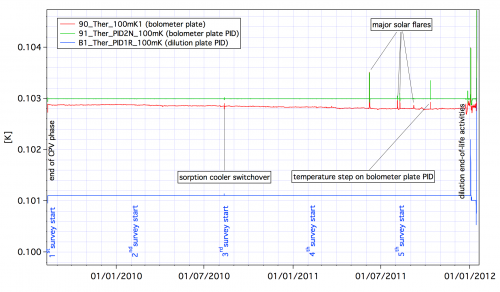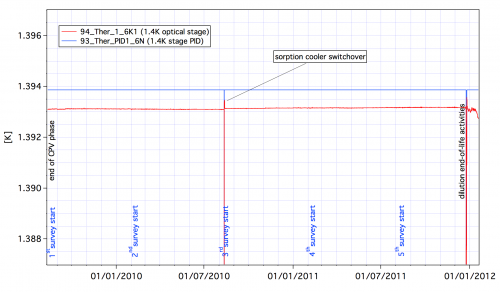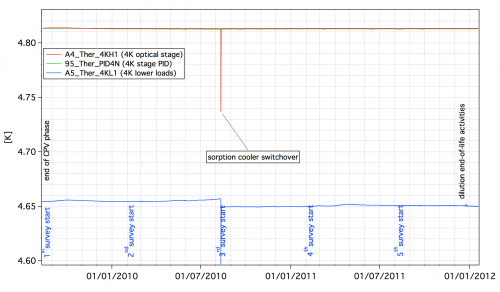HFI cryogenics
Cryogenics[edit]
(F .Pajot)
Dilution[edit]
The HFI 3He-4He dilution cooler produces temperatures of 0.1 K for the bolometers through the dilution of 3He into 4He and 1.4 K through JT expansion of the 3He and 4He mixture. The dilution cooler is described in detail in section 2.3.3 of Planck early paper II .
The dilution was operated with flows set to the minimum available values, and provided a total lifetime of 30.5 months, exceeding the nominal lifetime of 16 months by 14.5 months. The dilution stage was stabilized by a PID control with a regulating power between 20 and 30 nW providing a temperature close to 101 mK. The bolometer plate was stabilized at 102.8 mK with about 5 nW dissipated by PID regulation. The cooling power values were in very good agreement with those obtained during the ground tests and calibration. However, the cosmic particles interactions with the 100 mK stages induced temperature fluctuations and glitches on the thermometers measurements. The baseline correction of the bolometers signals from the 100 mK bolometer stage temperatures fluctuations is described in the TOI processing section.
At very low frequency, below 1 mHz, the temperature fluctuations are very well correlated with the high energy particles hit rate, as measured by the on-board monitor. At frequencies in the 10 mHz to 1 Hz range, single events inducing a global or partial temperature change of the bolometer plate are observed.
The 1.4K stage is very stable and given the very low coupling coefficients between the 1.4K optical components and the detectors no effect can be measured on the signal.
Detailed thermal analysis of the in-flight stability of the dilution cooler can be found in section 5.4 of Planck early paper II .
4K J-T cooler[edit]
The HFI 4K J-T cooler produces a temperature of 4K for the HFI 4K stage and optics and the precooling of the dilution gases. Full description of the 4K cooler can be found in in section 2.3.2 of Planck early paper II .
The 4K cooler was operated without interruption during all the survey phase of the mission. It is still in operation as it also provides the cooling of the optical reference loads of the LFI. The 4K PID stabilizing the temperature of the HFI optics is regulated at 4.81 K using a power around 1.8 mW.
The 4K J-T cooler compressors amplitude was set to 3450 micrometers during the CPV, and was maintained to this value during all the mission. Its cooling power is very stable and gives enough margin to cancel out the fluctuations induced by the sorption cooler fluctuations and adjustments. Following the unexpected shutdown of the compressors during CPV, their operation was nominal during all the rest of the mission.
Details on the in-flight performance of the 4K J-T cooler can be found in in section 5.3 of Planck early paper II .
(Planck) High Frequency Instrument
(Planck) Low Frequency Instrument
Calibration and Performance Verification


